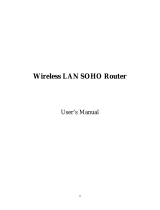
IP&MAC Binding ...................................................................................................................................................................... 55
Chapter 6 Wireless Tab ..................................................................................................................57
Wireless Basic Settings .......................................................................................................................................................... 58
Wireless Client Settings ........................................................................................................................................................ 60
Wireless AP Settings ............................................................................................................................................................... 61
Multi-SSID .................................................................................................................................................................................. 64
Wireless MAC Filtering .......................................................................................................................................................... 65
Wireless Advanced Settings ................................................................................................................................................ 66
Chapter 7 Management Tab .........................................................................................................68
System Log ................................................................................................................................................................................ 69
Miscellaneous ........................................................................................................................................................................... 70
Ping Watch Dog ....................................................................................................................................................................... 71
Dynamic DNS ........................................................................................................................................................................... 72
Web Server ................................................................................................................................................................................ 73
SNMP Agent .............................................................................................................................................................................. 74
SSH Server ................................................................................................................................................................................. 75
RSSI LED Thresholds ............................................................................................................................................................... 76
Chapter 8 System Tab ....................................................................................................................77
Device .......................................................................................................................................................................................... 78
Location ...................................................................................................................................................................................... 78
User Account ............................................................................................................................................................................. 78
Time Setting .............................................................................................................................................................................. 79
Firmware Update .................................................................................................................................................................... 81
Configuration ........................................................................................................................................................................... 82
Chapter 9 Tools List .......................................................................................................................83
Ping .............................................................................................................................................................................................. 83
Traceroute .................................................................................................................................................................................. 84
Speed Test .................................................................................................................................................................................. 84
Survey .......................................................................................................................................................................................... 86
Spectrum Analysis .................................................................................................................................................................. 87
Appendix A: Pharos MAXtream TDMA .............................................................................................88
Appendix B: Glossary ........................................................................................................................89
II





















